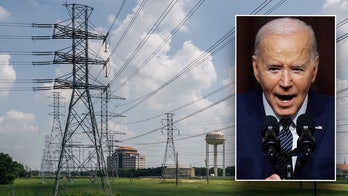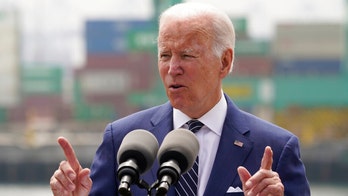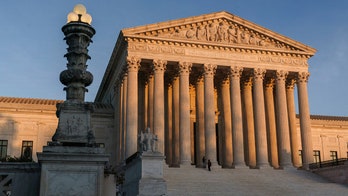Sen. Graham pushes for Judge Barrett's confirmation hearing after four senators test positive for COVID-19
Joel Rubin and Brad Blakeman examine whether President Trump's nominee faces new hurdles on her way to confirmation to the Supreme Court amid coronavirus outbreak.
Twelve words.
That’s how far former Senate Judiciary Committee Chairman Chuck Grassley, R-Iowa, got before Democratic Vice Presidential nominee and Sen. Kamala Harris, D-Calif., interrupted him in the opening moment of the confirmation hearing for Supreme Court Justice Brett Kavanaugh in September 2018.
“Good morning. I welcome everyone to this confirmation hearing on the nomination…” said Grassley before Harris and other Democrats commandeered control of the hearing with various motions, points of order and dilatory tactics.
“You’re out of order!” snarled a peeved Grassley at Harris. “I’ll proceed.”
The ensuing arguments – periodically punctuated by demonstrators chanting in the hearing room, prompting arrests by U.S. Capitol Police – sidetracked the hearing for the next 45 minutes.
The verbal brawl essentially diverted the hearing before it started.
What is past is prologue.
The explosive confirmation hearing for Supreme Court Justice Clarence Thomas in the fall of 1991 set the table for the Kavanaugh experience. The hyper-combustible Kavanaugh confirmation process propelled the confirmation hearings into the stratosphere. That sets the tables for hearings for Supreme Court nominee Amy Coney Barrett. Days before an election. The high court is poised to swing well to the conservative side of the ledger. The controversy of a breakneck confirmation process, augmented by how Senate Republicans dissed President Obama’s pick for the Supreme Court in 2016, Merrick Garland.
After Christine Blasey Ford appeared before the Judiciary Committee, leveling charges of sexual misconduct in high school against Kavanaugh, current Chairman Lindsey Graham, R-S.C., raged at his colleagues.
“This is not a job interview,” Graham fulminated to Kavanaugh from the dais. “This is hell.”
Graham accused Democrats of portraying Kavanaugh as a high school “Bill Cosby.”
“Boy, y’all want power. I hope you never get it,” Graham snarled at his Democratic colleagues, emerging as Kavanaugh’s most ardent defender.
And so now Amy Coney Barrett heads before the Judiciary Committee less than a month before the election. You couldn’t slather the hearing room walls with turpentine, give the senators cigarette lighters and expect a more incendiary mix. Some of this hearing will be remote with senators beaming in their questions due to a COVID-19 outbreak in the Senate. And no one is clear on the public’s role in this. Health officials shuttered the complex to the public since the pandemic struck in winter.
“If my Democratic friends want to turn it into an intergalactic freak show and bring back the protesters with genitalia-shaped headgear, I can’t stop them,” said Sen. John Kennedy, R-La., a member of the Judiciary Committee on Fox.
As pugilistic as the Kavanaugh hearings were, this October’s sessions for Barrett pose a different dynamic. Graham now wields the committee gavel and faces an increasingly tough re-election bid against Democratic nominee Jaime Harrison. And Harris, who made a mark in the Kavanaugh hearings is now on the Democratic ticket.
We speak all the time in presidential election years about an “October Surprise.” We’ve already had one. It’s hard to imagine that another “October Surprise” of 2020 won’t emanate from Barrett’s confirmation hearings.
Does Graham blow a gasket with Democratic tactics like he did two years ago? And even if Graham does, would such an outburst help or hurt him? Does Harris push to jam up the gearboxes like she did at Kavanaugh’s hearings? And, even if she does, or enters into a sharp exchange with Barrett, does that help or hurt?
Such risks. Such potential for benefits.
In addition to Graham, the Judiciary Committee features three other Republican members facing competitive re-election bids this fall: Sens. Thom Tillis, R-N.C., Joni Ernst, R-Iowa, and John Cornyn, R-Texas. Tillis tested positive late last week for COVID-19.
These are the types of moments which can crystallize the final weeks of a presidential campaign. It’s impossible to predict which approach may resonate with voters. Hyperbolic outbursts may fire up the base but dissuade undecided voters. A less kinetic approach could leave the base seething. And, frankly, none of this may matter at all because voters have already cast more than a million ballots and there aren’t many undecided voters to sway.
“This is going to motivate people in North Carolina to go to the polls. Particularly, if they go out and see what the alternative is,” said Tillis on Fox before his diagnosis.
No one quite knows exactly what this confirmation hearing will look like. It could be a cage match brawl.
The words “confirmation hearing” are nowhere in the U.S. Constitution.
Article II, Section 2 of the Constitution says the President has the power to nominate Supreme Court Justices. The Senate then provides “Advice and Consent.”
There’s nothing about individual meetings with senators. Stacks of paperwork. FBI background checks. Just the Senate to vote, up or down. Yea or nay.
Supreme Court confirmation hearings never existed until 1916. The Senate heard from witnesses both for and against Justice Louis Brandeis. Brandeis didn’t attend the hearing.
No Supreme Court nominee ever talked with senators about their confirmation until Justice Harlan Fiske Stone did so in 1925. There were questions about Stone’s ties to Wall Street.
Felix Frankfurter was the first justice to attend their own confirmation hearing in 1939. Frankfurter attended – but did not speak.
The current model for modern confirmation hearings came in 1955 for Justice John Marshall Harlan.
But TV – and controversy – presented an altogether different factor for confirmation hearings. Such was the case with the 1991 hearings for Supreme Court Justice Clarence Thomas. An epic battle as law professor Anita Hill lodged sexual harassment charges against Thomas. This was really the first time the nation wrestled with the idea of sexual harassment in the workplace. There was discussion of porn stars and private parts as TV networks took the hearings live – through the weekend! CBS even debated whether to stick with the hearings or show the baseball playoffs one night. And none of the white male senators looked good – especially up against an African American man and an African American woman. Thomas declared that the hearing was “a high-tech lynching.” The chair of the hearings? Joe Biden, then a senator from Delaware.
The Kavanaugh hearings weren’t much better. Women lining the walkways of the Hart Senate Office Building, dressed as though they just came from wardrobe in The Handmaid’s Tale. The arguing initiated by Harris and championed by Sens. Cory Booker, D-N.J, and Richard Blumenthal, D-Conn. Graham’s philippic, directed at his Democratic colleagues.
These hearings are made for television. They contain drama. Verbal broadsides. Soliloquies. In both the Thomas and Kavanaugh confirmation processes, everyone thought the hearings were over. And then, like any good movie or book, a late plot twist emerged: accusations from Hill and Ford.
One can only anticipate what to expect in Barrett’s hearings in such a supercharged atmosphere in the age of coronavirus. But sometimes on Capitol Hill, when things are so amped up, senators actually dial it down a notch. Sometimes a hearing like this can plod along. Especially if it’s partially virtual. It’s a paradox, to be sure. But it does happen.
One thing for sure: everyone will be watching. And these hearings could present a final, galvanizing moment, before the election.





